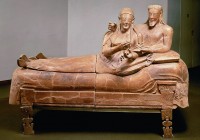 The skeletal remains of an Etruscan aristocrat found in an intact tomb in the ancient necropolis of Tarquinia last month turn out to be female. Archaeologists had assumed the person laid out on a funerary bed carved out of the rock with a spear placed by the body was a man, but osteological analysis has found that the bones belonged to a woman between 35 and 40 years of age. It’s the cremated remains found along with what appears to be an unopened jewelery box on the smaller bier across from the skeleton that belonged to a man. He appears to have been younger than the woman and his remains were placed in the tomb years after hers, suggesting they may have been mother and son.
The skeletal remains of an Etruscan aristocrat found in an intact tomb in the ancient necropolis of Tarquinia last month turn out to be female. Archaeologists had assumed the person laid out on a funerary bed carved out of the rock with a spear placed by the body was a man, but osteological analysis has found that the bones belonged to a woman between 35 and 40 years of age. It’s the cremated remains found along with what appears to be an unopened jewelery box on the smaller bier across from the skeleton that belonged to a man. He appears to have been younger than the woman and his remains were placed in the tomb years after hers, suggesting they may have been mother and son.
The small bronze vessel known as a pyx that was found on her funerary bed was X-rayed and found to contain bronze or silver needles and what may be a spool. The pyx itself is considerably older than the 7th-6th century B.C. burial, so it may have been an heirloom handed down to the noblewoman.
The archaeologists’ initial gender assumptions based almost entirely on the placement of the grave goods — spear = male, jewel box = female — have thus been thoroughly upended. Alessandro Mandolesi, Etruscanologist with the University of Torino and dig leader, explains (translation mine):
“It’s not usual to find a woman’s body with a spear. For this reason, in the beginning, we thought we’d found a warrior. After seeing the results of the anthropological analyses of the skeleton and after finding the burials of the male, we have a clearly picture of what we’ve found. There is a high probability that the spear was placed as a symbol of unity between the two deceased.”
 That last part makes zero sense to me. The spear was found next to the skeleton’s right shin, between the bones and the wall of the tomb. The ashes of the male are on the smaller bed against the opposite wall. In what way does the spear indicate connection, never mind unity, between the two residents of the tomb? When they thought the skeleton was male there was no talk of the spear as symbol of union because weapons are indicators of warrior or at least leadership status. Why should that most obvious of associations be discarded just because the skeleton is female? Notice there is no tortured attempt to explain the jewelry box on the man’s funerary bed as justified by his relation to the woman.
That last part makes zero sense to me. The spear was found next to the skeleton’s right shin, between the bones and the wall of the tomb. The ashes of the male are on the smaller bed against the opposite wall. In what way does the spear indicate connection, never mind unity, between the two residents of the tomb? When they thought the skeleton was male there was no talk of the spear as symbol of union because weapons are indicators of warrior or at least leadership status. Why should that most obvious of associations be discarded just because the skeleton is female? Notice there is no tortured attempt to explain the jewelry box on the man’s funerary bed as justified by his relation to the woman.
The Etruscans certainly weren’t so narrow-minded. Greek and Roman sources were scandalized by Etruscan society (or at any rate by the urban legends they’d heard about it). The 4th century B.C. Greek historian Theopompus of Chios described gender relations in Etruria as shockingly liberated from the Greek perspective:
Sharing wives is an established Etruscan custom. Etruscan women take particular care of their bodies and exercise often, sometimes along with the men, and sometimes by themselves. It is not a disgrace for them to be seen naked. They do not share their couches with their husbands but with the other men who happen to be present, and they propose toasts to anyone they choose. They are expert drinkers and very attractive.
The Etruscans raise all the children that are born, without knowing who their fathers are. The children live the way their parents live, often attending drinking parties and having sexual relations with all the women. It is no disgrace for them to do anything in the open, or to be seen having it done to them, for they consider it a native custom. So far from thinking it disgraceful, they say when someone ask to see the master of the house, and he is making love, that he is doing so-and-so, calling the indecent action by its name.
When they are having sexual relations either with courtesans or within their family, they do as follows: after they have stopped drinking and are about to go to bed, while the lamps are still lit, servants bring in courtesans, or boys, or sometimes even their wives.
 The emphasis on sexual permissiveness in Etruscan society may be an assumption of his, incidentally, an automatic inference drawn from the mere fact that women in Etruria had so much freedom than Greek women did. In Greek and Roman society at this time, the only women present at dinners with men were prostitutes and servants. Respectable women did not socialize freely with men. Etruscans, on the other hand, had dinner with their wives and sometimes even had sex with them afterwards, much to Theopompus’ shock (horror?). If they recline on dinner couches with men not their husbands, goes the logic, then they must be sexually promiscuous.
The emphasis on sexual permissiveness in Etruscan society may be an assumption of his, incidentally, an automatic inference drawn from the mere fact that women in Etruria had so much freedom than Greek women did. In Greek and Roman society at this time, the only women present at dinners with men were prostitutes and servants. Respectable women did not socialize freely with men. Etruscans, on the other hand, had dinner with their wives and sometimes even had sex with them afterwards, much to Theopompus’ shock (horror?). If they recline on dinner couches with men not their husbands, goes the logic, then they must be sexually promiscuous.
The evidence we have from funerary inscriptions and artistic depictions indicates Etruscan women were prominent and had some measure of equality with men. For instance, many tombs inscribed with the name of the deceased mention both their parents’ names. The mothers keep their own names and can even pass it down to their children. They also owned property independently they could bequeath to their children. Etruscan couples are often depicted in a loving embrace on sarcophagi, like the beautiful 5th century B.C. Sarcophagus of the Spouses now in the Villa Giulia museum in Rome, or one from 6th century now in the Louvre.
That’s not to say that the headlines should now all scream “Tomb of Etruscan Warrior Princess Found!” Just because she was buried with a weapon doesn’t mean she was a military leader who actually wielded said weapon. It could be a symbol of leadership or strength. It could be of sentimental significance to her or something associated to her family.